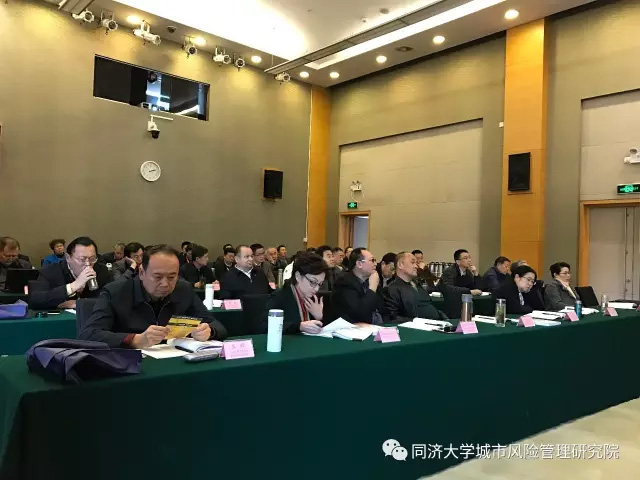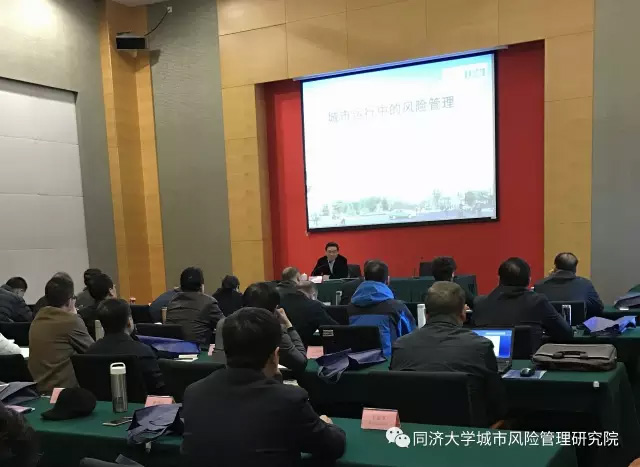On March 14, 2017, Mr. Sun Jianping, Dean of the URMI, went to the China Executive Leadership Academy Pudong (CELAP) to give a lecture on “Risk Management in Urban Operation” for leaders at the departmental and bureau levels of the People’s Government of Xinjiang Uygur Autonomous Region. Presiding over the event was Professor Liu Zhexin, Director of the Department of Teaching and Research on Law and Humanities, CELAP.

Mr. Sun Jianping mentioned in his lecture that “What happens in Shanghai today will happen in many domestic cities tomorrow”. Shanghai has been the first city to encounter certain urban management issues, which many other cities have not yet encountered. These need to be explored and studied to provide experience for other cities.
Mr. Sun Jianping has many years of work experience in the construction of traffic systems, which have enabled him to have many personal and practical experiences in urban risk management, in addition to much more feedback. In his lecture, Mr. Sun Jianping made a detailed presentation and shared his experience regarding the background, problems, thinking, countermeasures and practices involved in urban risk management. He said that the pursuit of urban risk management is inseparable from the reality of new challenges and new situations when urban development in China enters into new stages. Many of the former “urban problems” and “urban diseases” have evolved into “urban risks”.
Because of a number of issues, it is necessary to upgrade from daily safety management and emergency management to risk management, as well as strengthen preventative measures. Risk control in metropolises and megalopolises has become increasingly urgent in recent years. Faced with more and more complex problems and greater threats, the management system which has been focusing on daily safety management and emergency management is no longer able to fully meet the needs for urban management.
The establishment of the urban risk management system has reached a critical stage. It is necessary to build a prevention and control system which can scientifically make prevention beforehand, effectively provide control in the event of an incident, and remedy afterwards to keep the impact of losses to a minimum. Systems, data, platforms, standards, assessments and safeguards must be optimized and perfected. Currently, five “transformations” must be implemented perfectly.
First, the management concept must be converted from focusing on the event to focusing on the risk. In order to minimize risk, it is necessary to overcome the limitations of the development of management measures on specific events. To examine the urban risk from a more systematic point of view, risk analysis should be taken as a basis for policy and management, and it is also necessary to improve urban risk awareness training, by any means necessary, to all sectors of society, especially the leaders at all levels.
Second, the principle of response needs to be changed from the habit of “making remedy” to “taking precaution” conscientiously. It is well-known that “he who does not think of the future is certain to have immediate worries”. In the current complex environment, nothing can be improved by trusting in luck, and people should pay attention to potential problems for every event, estimate the possible consequences, preparing for the worst, while hoping for the best. The Government should give more consideration to financial investment on the implementation of “taking precautions”, and make institutional arrangements.
Third, the focus of work shall be converted from simply dealing with “emergency afterwards” to making “prevention and control beforehand and in the event of an incident”. When it comes to urban risk management, it is necessary to pay attention to daily management and emergency management, in addition to the management beforehand and in the event of an incident. For the metropolis of Shanghai, the analysis and activating mechanism for early warning index of urban operational risk should be set up at the municipal level as soon as possible. The integration analysis of urban risk can be implemented by means of big data. Real-time early warning is possible for contingent risks, and countermeasures can be taken in a timely manner.
Fourth, the main work should be redirected from unilateral authority dominance to encouraging social participation and making the market mechanism play a role. Urban risk management requires unified planning and guidance from government departments, and must not be a “one-man show” played only by the government. Unilaterally, with its manpower, material and financial resources alone, the government is unable to fully cope with the stress of complex risks. It is necessary to give full play to the decisive role of the market in resource allocation, and to encourage the full participation of social organizations, grassroots communities and the general public.
Fifth, the relationship between government and communities should be improved from merely taking a passive role in dealing with crisis of public relations to taking an active role in assuaging the concerns of the public. Once a crisis occurs, it is necessary to tell the truth and guide public opinion at the beginning, which is an important task of urban managers. With the rapid development of the Internet and social media, the spread of information after any given incident is now different from that of the past, and the speed at which the formation of public opinion occurs is also much faster than that of the past. In this regard, the urban management should get rid of the negative state of crisis public relations in the past, and it should have a more active and positive attitude to guide the public opinion. It is necessary to make full use of new media means, and to disclose authoritative facts and core information to guide public sentiment. Likewise, in their daily work of innovation, the urban government should comprehensively apply social media and other means to maintain effective communication between the government and the public, and to guide the public to become strong supporters and co-participants in urban risk management. It is of great advantage to have openness rather than be secretive in this era of the internet.

Mr. Sun Jianping pointed out that the current development of urbanization in China had entered a new period, and world-class urban agglomerations, representing the Yangtze River Delta, Pearl River Delta and Beijing-Tianjin-Hebei Region, will gradually rise to lead the trend of global urban development in future. Therefore, urban risk management in China must achieve three major leaps. The first leap is that from emergency management to systematic risk management; the second leap is from measures to remedy afterwards and in the event of an incident to early warning prevention and control system; the third leap is that from government-led single-to-multi mode to social participation of an integrated management and control system.
In the lecture, Mr. Sun Jianping also related several situations found within Shanghai, such as the introduction of an insurance mechanism in the construction engineering field, the implementation of third-party monitoring in the transportation industry, the early warning risk management system for meteorological disasters, which drew an enthusiastic response from the students.
At the end of the lecture, leaders at the departmental and bureau levels from Xinjiang Autonomous Region launched into a discussion on the local existing problems. Mr. Sun Jianping also interacted with the students on the green city concept, including the planning of a non-motorized traffic system, underground pipeline quality and safety hazards, security prevention and control, as well as some other issues.

